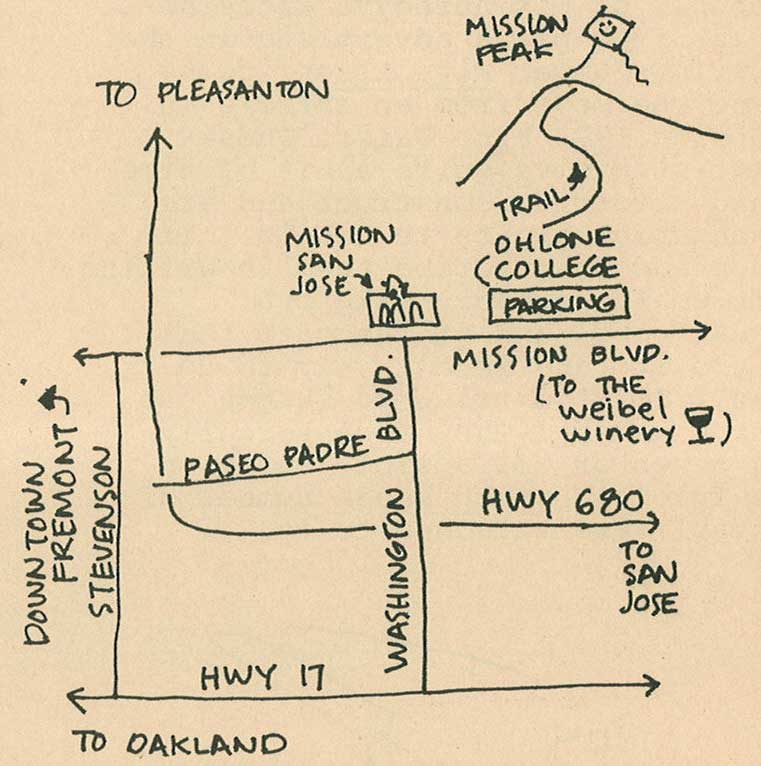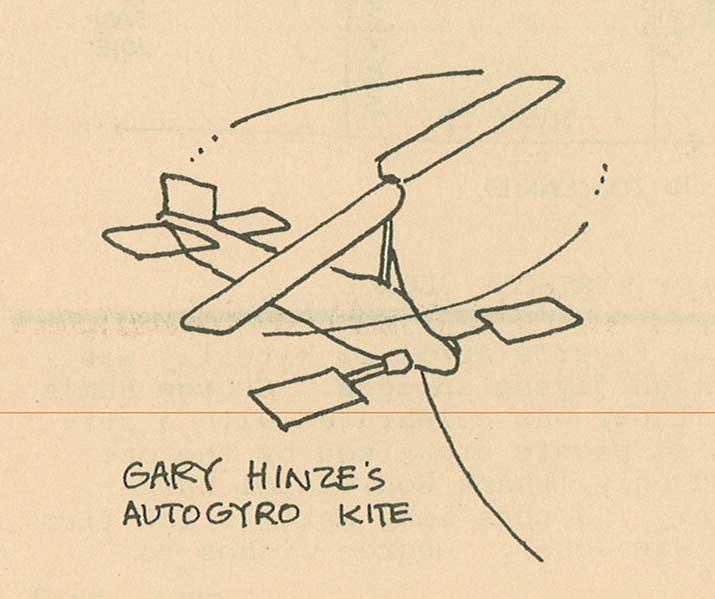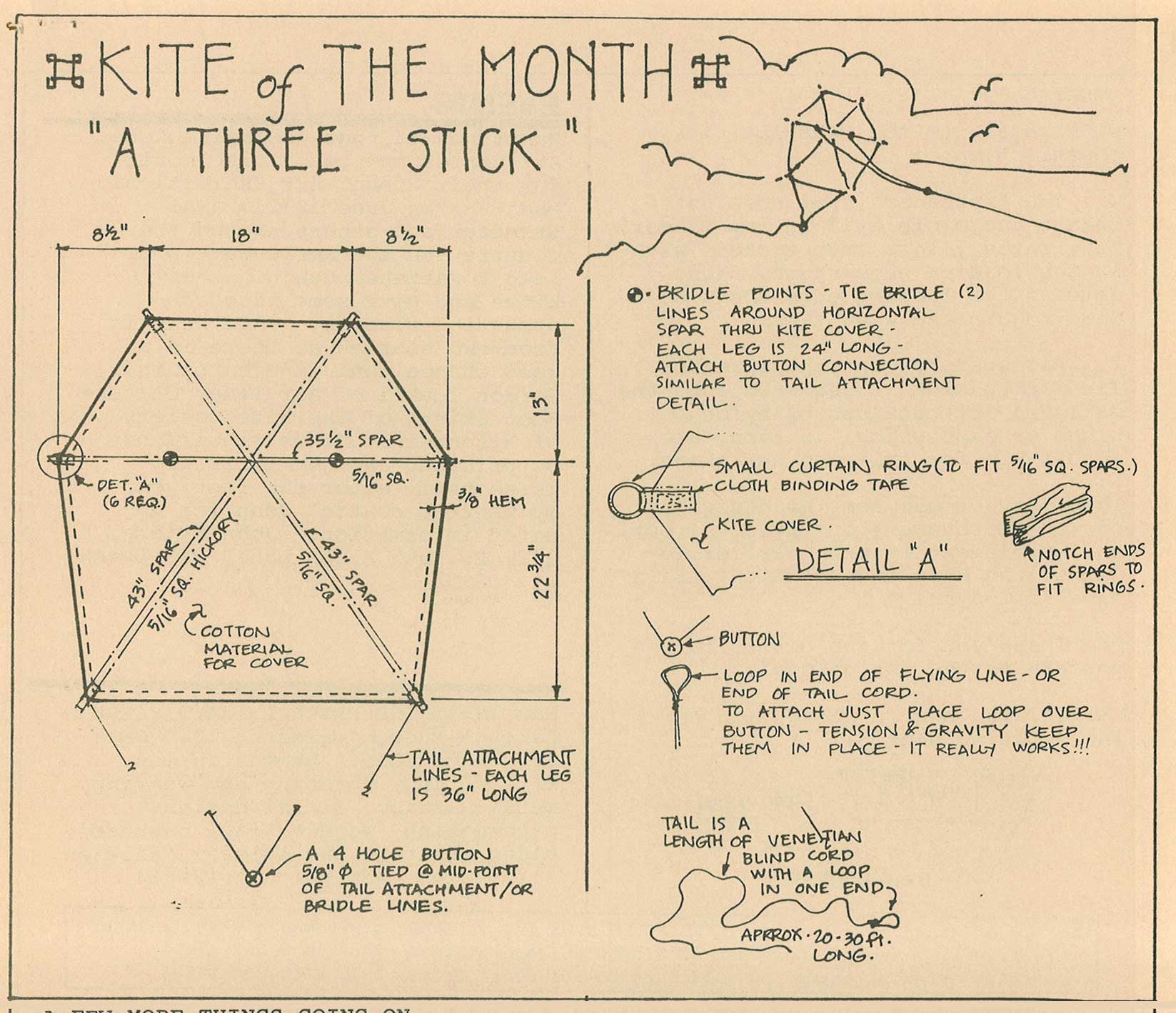By Lee Toy
Vol. 4 No.3 – Sep. – Oct. 1981
KING OF THE DRAGON KITES
LOOK UP IN THE SKY, IT’S A BIRD, NO, IT’S A PLANE, … NO IT’S… Tom Henry’s 1,250 foot dragon kite. On April 29,1981 Tom, with the assistance of George and Marion Ham flew the longest dragon kite on the Green if not the World. The launch was at 4pm. in about 12 to 15 mph wind. The head of the dragon is approx. 7′ x 10′ and is flown on 500# test line. It was out 1000′ at approx. 70-80 degrees.flight angle. GOOD GOING TOM…
BUILDING TIPS
Spinnaker scrap pallet: If you have lots of spinnaker scraps from the sail-loft and don’t know how to store them, try this method from George Peters in Hawaii: He made a cardboard bin with sectional dividers to separate various colors. To store your scraps simply roll them up and set them vertically in the sections. This not only keeps them in order but also eliminates the need to iron them if they are allowed to sit for a few days.
NATIONAL KITE WEEK
Don’t forget to mark you calendars if it isn’t too late already. The official AKA has designated May 3-9 as…are you ready for this Virginia, NATIONAL KITE WEEK, with Saturday May 9 aliOicfficial Kite Day for America –What the candy and flower industry has done for secre-taries the AKA has done for us…THANKS.
Gordon Teekel did a great job on the posters and flyers that were distributed to regional directors and retail kite outlets to help spread the word. (see enclosed)
May 9, 1981 MISSION PEAK HIKE AND KITE FLY 12 noon at the top.
Hike from behind the swimming pool at Ohlone Jr. College. A 4 mile hike, bring a canteen, lunch and a kite you can pack. Approximately a 3.5 hour hike. You will also help dedicate the new trail markers which the Fremont Rotary Club has put up. More information?
Charles Chesterman is the organizer of this one: (415)657-2758

HAPPY BIRTHDAY GEORGE
Kite Flyer’s April 12 kite fly was a high flying success. George Ham’s birthday was celebrated with a sur-prise picnic organized by the one and only (thank God) Carol Hakke-. Henry ( sounds like Marty’s law firm in San Jose). George wishes to thank all of the people who helped make this birthday a most memorable one. And anyone who saw the cake provided by Ms. Henry won’t soon forget the sugar figure on the top. (what are you going to put on the top of my birthday cake?)
Rubie made some delicious ribs and ham, Roland did a cole slaw, Marion and Helen did potatoe salads, Marty and the Urners provided beer, The Walkers brought cheese and fruit, and some home grown celery, Stan brought some ice cream and some unforgetable Champagne, I made some ribbons. We had plenty to eat and drink and topped off the afternoon with some splendid winds and sunny skies.
It was good to see some of our more distant members and their kites. Gary Hinze brought up a couple of his Autogyro kites he made from plans advertized in the Spring-Summer Kite Lines, pg.45 and one made from an article in Spring 1972 Kite Tales. These kites involve quite a bit of time and effort to construct and are wonderful sights to behold. If you had to describe them in writing it would probably take over 1000 words and at the rate that I type it take me all year to do it. So I’ve tried to sketch one from memory: They are basically a fixed or collapsible rotor on a fuselage which has a number of stablizers attached to it.

Neil Thorburn showed up with a new reel that is powered off his car battery. It beats winding the line up by hand! He had along some sample pages of his latest kite book(all done by hand with stenciled lettering ) hopefully he will get it printed so that we will have in his words “a kite book with NEW mistakes in it” This was in reference to the people who keep repeating the old mistakes in kite books.
Sam and Nancy Urner were down from Sacramento. I didn’t see any new kites in his stable but a new hat with wings on it to help him fly better.
Geoffery Paris had a train of Mylar Eddy kites. Paul aired out some of his splendidly sewn parafoils and a Parachute kite by Ed Grauel.
Big George tried to get his “Tail” up but there just wasn’t enough wind for it. Mr. Lee put up his train of character kites with the message “HAPPY BIRTHDAY GEORGE” sanwiched inbetween the pandas and Snow White and the Majorett. John Kramer had a Summer Snowflake, the first one of those on the Green. I flew one of the Japanese kites I was given while visiting Shirone last year, as well as a 25 section centipede. A friend of George’s from Alameda dropped by with a collection of Nishi Kites that he picked up at the Flea Market.
While visiting Hawaii in March, I was able to attend the 14th Annual Oahu Kite Flying Contest. It was a well organized affair sponsored by the Department of Parks and Recreation with a helping hand from the Elks Club. It was held at Queen Kapiolani Park at the foot of Diamond Head, a beautiful backdrop of mountains and palm trees for a sky full of kites.
This year’s festival was not as well attended as some in the past I was told. There were 17 events in the Junior Division and three trophies for each event. There were 5 events for the Senior’s Contest with two trophies for each event. As you can imagine it was a long day. At noon the Royal Hawiian Band did a concert beneath the trees and the officials took a well deserved break. The winds were a bit unstable and the field had to be rearranged to suit the wind direction several times. Overall I would say the festival was a success by the smiles on the faces of tired kitefliers.
THE THREE STICK REVISITED
Kite Flyer’s Kite of the month is not a new kite but an old kite with a new twist. I saw this kite flying in very high winds on the island of Kauai one afternoon. I followed the line to it’s end (as all good kite enthusists do when seeing an interesting objet d’sky) and met a most inter-esting fellow (as many kite people are). He said that he was inter-ested in the efficency of the kite as a tool in meterological study, which was being done in 1923-24. The maker who wishes to remain anonymous will be called Mr. Ed. Mr. Ed made over 100 kites similar to the ene shown and began experimenting with bridle attachments and cover taughtness until he arrived at the one presented in this issue.
The most unique feature on this kite is it’s bridle configuration and line attachments. Instead of the typical 3 or 4 line bridle Ed’s has only two lines and they are both on the horizontal cross spar. Ed uses a simple button method of attaching his lines, and tails to the kite. He mentioned that one of his kites were in the Garber collection at the Smithosian, it might be interesting to see if it’s still there.
The kite is made from straight grained Hickory sticks 5/16″ square. ( there is very little flex) The cover is a light weight cotton fabric (yellow). His tail is simply a length of venetian blind chord and he flys with carpenter’s Chalk line attached to the bridle by a button.
Mr. Ed said he was mostly interested in the angle of flight and its ability to fly in a variety of wind conditions. On the day I saw the kite it was gusting from 15-20mph and the kite was maintaining about 70 to 80 degree flight angle and looked rather steady, so I would venture to say he had succeeded quite well in his goals.
LETTERS TO THE EDITOR
Dear TOY!
How are you
It’s Wonderfull meeting last year, TOKYO, SAN FLANSHISKO, SEATTLE! Thank you verry verry much. You are verry kind hospitality for me! I never forget kite flying with you and many A.K.A. TAKOKICHI!
Please my best regards to your friends.
See you again!
Nishibayashi
Enclosed in the letter was a miniature kite with a painting of Nishi himself on the cover.
C.P.,C.G. AND ANGLE OF ATTACK Dear KITE FLYER,
The discussions of bridling, C.G. and C.P. has led me to put down my glue bottle and take typewriter in hand. I have already written to Guy Aydlett and enclose a copy of that letter.
If you bridle a kite at the C.G., it will not fly. The C.P. will never coincide with the C.G. in steady flight.
The C.G. has a definite physical location because the elementary weight vectors are all parallel and the distribution of the weight does not change when the object is rotated. The vector sum of all the aerodynamic pressures on a kite acts along a definate line. but does not have a physical location. The C.P. is conveniently defined as the intersection of this line with some arbitrary chord line, such as the kite’s centerline. The C.P. location varies with the attack angle. On kites it is generally in the range of 20 to 33% of the mean chord and is further foreward at lower attack angles. If you think of it as a teeter-totter, you can see that the string force will have to be ahead of the C.P. in order for the forces to balance. The C.P. locations can be determined by ballasting the nose of the kite until it will glide.
In gliding, the C.P. coincides ap-proximately with the C.G.
The Angle at which a kite will hang from it’s bridle is not the angle of attack in flight. The angle of attack varies with windspeed, decreasing with increasing windspeed. It depends on the interplay of C.G., C.P. and bridle. The angle at which a kite will hang is determined solely by the relation between the bridle point and the C.G.; it will hang so that the C.G. is directly below the point of suspension. This will be true no matter where the point of suspension is located. A plumbline through the point of suspension will always pass through the C.G. If you put the bridle point directly on the spine, adjusted so the kite would fly well, the kite would hang near vertical. If you used a bridle that was many times longer that the kite, adjusted so the kite would fly well, it would hang nearly horizontal. Thus the angle at which the kite hangs has nothing to do with bridling for flight.
Good Flying, Gary Hinze
ed. Thanks for the good letter and thoughts on these subjects. Gary has since sent me a 48 page article he had written in 1975 on the aero-mechanics of kites so I won’t make any more hasty statements concerning C.P.,C.G. and bridling.
MARGARET GREGER WHERE ARE YOU?
George Greger had passed thru town the other day and phoned some news of Margaret’s activities. It seemed that Margaret will be doing a gallery showing along with a potter and another artist up at the Seattle Science Center. OOPS RUN THAT ONE BY ONCE MORE PLEASE
The following is a excerpt from a letter from Curtis Marshall regarding the MARSHALL KITE featured in Jan.-Feb. Kite Flyer.
“With regard to Hod Taylor’s part in the Marshall design: The answer is strictly, he was not involved in any way.
Although I was not aware of Taylor or any of his designs in 1973 when I did my design, I have since become aware that Taylor was one of many who had made winged box kites. I do not know when Taylor first used rigid leading edges for the wings, but certainly, that idea predated me, Hod Taylor, and Al Hartig, as well.
With regard to the MARSHALL geometry, the unique features responsible for it success are:
1. The spreader bar and all spars are simple multiples of the basic box dimension,thus, not only providing an ease of construction, but also an ease of collapsing for transport.
2. The trailing edges of my wings are not perpendicular to the fore-aft axis, but are swept forward, (as clearly shown in your drawing). This feature provides a much more effective weight-to-lift ratio than with other wings and also provides a much more stable flight. With this wing design, there is no need for slitting or other drag producing measures.
A FEW MORE THINGS GOING ON
May 23- 25 Kite demonstrations by Wind, Wave and Wheel of Capitola CA. at the Classic Air Show in Watsonville.
May 25 kite demonstrations and balloon race from the University of Santa Cruz. Check with Bob Broms of Wind, Wave and Wheel in Capitola for these (408) 462-2026. Bob had informed us that they had just finished their Spring festival at the Beach which is an annual affair occurring on the first Sunday after the Equinox. If any one attended, how about a report?
May 31 1981, SKY LINES at Hawaii Volcanoes National Park. An aerial event above the Kilauea crater area featuring kites and banners by artist-craftsman, George Peters and kites made during a weekend of work-shops at the VOLCANO ART CENTER.
For information and registration : (808)967-7511
George Peters is a kite maker from Ohau whose kites are beautifully crafted in spinnaker cloth. (more on George in the next issue of Kite Flyer).
With regard to the MARSHALL construction:
1. The “spreader” spar does not engage the cloth sail in any manner, but, rather, fits into sockets within the leading edge spars, thus, forcing the leading edge spars outward toward the wing tips.
2. All spars except the spreader lie within cloth tubes sewn into the sail and are retained by nylon plugs or caps which, in turn, are adjustable for trim and shrinkage.
Thus, as you can see, my design is not an improvement on Taylor’s, but an improvement on much earlier designs, the only one of which with a name is Conyne. “
ed. Thank yoll for the clarification concerning the design origins.
Curtis also sent a correction to the bridling sketch:
EVENTS
Rumor has it that the Milwaukee Art Center may use a kite motif for their Annual Art Exhibition and Fair on June 19-21. Tal Streeter and others around the country and the world have promised to attend, exhibit their kites and give some kite construction classes. This news is from two sources so there is a good chance that it’s happening. Gordon Teekel of Air Time, CA. and John Skiera of The Kite Society of Wisconsin. Since we will not be printing another thrilling issue until after the fact you my want to contact John for updated information: John Skiera, 3481 E. Ruth Ellen Lane, Oak Creek, WI. 53154
May 16-17 THE NATURAL CRAFT FAIRE Oakland Museum gardens, 1000 Oak St. in Oakland. Demonstration kite flying, spinning and weaving, metal working, floral design, papermaking, woodworking, basketry, plant printing and special children activities.
Admission is FREE!
By way of standard reference–KITE FLYER NEWS is available six times a year (weather permitting) at the minimal cost of a trip to Doggie Diner–$5.00 a shot. Send all money, trading stamps or gold bars to 861 Clara Drive, Palo Alto, CA 94303.




